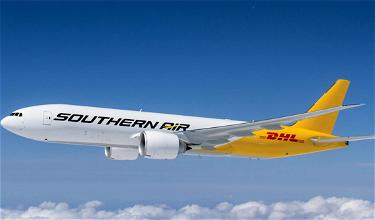I suppose all’s well that ends well, though I still find this to be an interesting story…
In this post:
Cargo 777 stalls on takeoff from JFK
This incident happened on November 15, 2020, and involves Southern Air flight 947. The cargo Boeing 777-200 with the registration code N702GT was operating a flight from New York to Seoul Incheon, and had a stall incident shortly after takeoff. This was a roughly eight year old plane that initially flew for LATAM Cargo.
Here’s a VASAviation video that has the ATC audio, and also shows a recreation of the radar:
To summarize what’s in the video:
- The plane takes off from runway 22R at JFK
- The pilot contacts departures as they’re climbing through 4,000 feet, for an initially cleared altitude of 5,000 feet; you can already start to hear alarms in the cockpit at this point
- As the pilot confirms instructions given by the air traffic controller, he starts yelling “STALL, STALL, STALL, STALL, STALL, STALL!”
- At that point the pilot asks the air traffic controller to standby; for the next 90 seconds, the controller tells other pilots to standby as well, given the situation
- On radar you can see the plane losing altitude
- The controller asks the pilot if he can climb, and he’s told once again to standby
- The plane eventually starts to gain altitude, at which point the pilot requests a new altitude and a high speed climb, confirming they are “good” now
- The plane continues without further issues, and lands in Seoul Incheon after a 14hr36min flight
For those of you not familiar with Southern Air, it’s a US cargo airline that’s a subsidiary of Atlas Air. Southern Air operates a fleet of 17 aircraft, including 737s and 777s. Southern Air primarily operates on behalf of both Amazon Air and DHL Aviation.
What exactly happened with this stall incident?
Obviously I’m not the NTSB and I’m also not a 777 pilot, but I did pull up some data from the flight that points to what may have contributed to this. Flightradar24 tracks the speed and altitude of flights, so it’s interesting to compare the initial climb out of JFK for the same flight one week apart (of course there are potentially other factors, but in both cases we’re talking about the same plane on an ultra long haul flight).
Here’s the data for the flight that had the stall incident (the first column in red shows the altitude, while the second column in red shows the speed):

Here’s the data for the same flight one week earlier (the first column in red shows the altitude, while the second column in red shows the speed):

You’ll notice some significant differences:
- First of all, we can see just how much altitude was lost with the Southern Air flight that had the stall incident; it lost about 550 feet, as it climbed through 4,150 feet, and then descended down to 3,600 feet
- The flight that stalled was climbing out at a slow speed, it climbed through ~4,300 feet (its highest altitude before the stall incident) at 216 knots, while the flight that was fine was going 280 knots at that point
The 777 is known for having a high minimum “clean speed,” which is the minimum speed the plane needs to fly with landing gear and flaps retracted. We don’t know when flaps were retracted, but the plane typically needs to be going nearly 250 knots at that point.
Like I said, all I’m sharing is some basic observations based on the data. For a more in-depth look at this, check out this YouTube video, where a 777 pilot shares his take on the situation:
It’s a fascinating explanation that answers many question you could have about this incident. His observations come down to a few main points:
- A fully loaded 777 has a high minimum speed, close to 250 knots
- As a pilot on a “heavy” 777 you’d ordinarily request a high speed climb early on, because there’s not much margin between the minimum speed and the typical limit of 250 knots under 10,000 feet
- His main questions are if the pilots had inputted the right information into the flight management computer; if they entered the wrong weights then they might have been using an incorrect flap schedule, meaning flaps may have been retracted too early (which also increases the minimum speed)
- He suggests that as long as the pilots quickly reported this incident, they likely wouldn’t be in trouble
Bottom line
Last week a Southern Air 777 had a stall incident on departure from JFK. Fortunately the pilots managed to recover from the situation after the plane dropped 550 feet, and the plane was able to continue to Seoul Incheon.
It’s anyone’s guess what exactly happened, but based on the data it’s pretty clear that the plane was climbing at a slower speed than usual, which isn’t great when you consider the 777’s high minimum clean speed.
What do you make of this incident?
(Tip of the hat to SINJim)


As a retired airline Captain (did not fly the 777) and current simulator instructor, I can say with certainty...something "went ugly early". Either a data entry error in the FMS caused incorrect reference speeds, or (more likely) a simple over-pitch shortly after rotation. I see it not infrequently in the simulator during training events.
Yes, stalls are practiced in virtually all configurations with the INTENT to never have it happen in line operations. Should...
As a retired airline Captain (did not fly the 777) and current simulator instructor, I can say with certainty...something "went ugly early". Either a data entry error in the FMS caused incorrect reference speeds, or (more likely) a simple over-pitch shortly after rotation. I see it not infrequently in the simulator during training events.
Yes, stalls are practiced in virtually all configurations with the INTENT to never have it happen in line operations. Should a low speed / high angle of attack event occur, crews are trained to recover, but it SHOULD NOT happen. In this case recovery was made (albeit scary) with minimum loss of altitude...and my guess...maximum soiling of underwear.
This doesn't make sense as written. A sophisticated modern aircraft should not allow itself to get near a stall situation. It should 'shake the stick' upon a climbing departure that is too slow too steep or indeed any situation where the control software senses a too high angle of attack.
According to the chart, the airplane climbed from 1,425' to 2,300' in only 12 seconds. That works out to 4,375 fpm during that segment. Since that kind of climb rate would obviously not be in the profile at that altitude and configuration (the aircraft should be shallowing it's climb rate in order to accelerate), and a premature flap retraction would not generate an increased climb rate, I gotta believe the pilots over controlled the pitch...
According to the chart, the airplane climbed from 1,425' to 2,300' in only 12 seconds. That works out to 4,375 fpm during that segment. Since that kind of climb rate would obviously not be in the profile at that altitude and configuration (the aircraft should be shallowing it's climb rate in order to accelerate), and a premature flap retraction would not generate an increased climb rate, I gotta believe the pilots over controlled the pitch either through inattention or lack of finesse, which resulted in the airspeed decrease, altitude surge, and corresponding stall warning.
Or possibly but less likely, a computer malfunction. But if a computer did that, and they knew it, they would be fools for continuing the flight with a known computer issue.
Flying straight to ICN as well huh? Can’t imagine how ouch fuel they were carrying!
Most very heavily loaded aircraft departing JFK request a high speed climb before their departure. This crew apparently didn't. While this "stall' wasn't anything like a nose over uncontrolled rapid descent, it did result in some loss of altitude before the high speed climb was requested and initiated. As a former military pilot, I can tell you that these situations are included in simulator training. At their weight, the request probably should have been an...
Most very heavily loaded aircraft departing JFK request a high speed climb before their departure. This crew apparently didn't. While this "stall' wasn't anything like a nose over uncontrolled rapid descent, it did result in some loss of altitude before the high speed climb was requested and initiated. As a former military pilot, I can tell you that these situations are included in simulator training. At their weight, the request probably should have been an item in their checklist I'm thinking.
Typically in a stall you would lower than nose the decrease the angle of attack. The loss of altitude was probably deliberate to gain airspeed and break the stall. I doubt they were in a full power in stall.
Thanks for posting. I know it has nothing to do with the normal reviews or miles/points redemptions but I find it fascinating. Love the break down and insights of the 777 pilot.
Are the speeds listed ground speed or air speed?
Don’t 777 pilot train for power on stall? It shouldn’t be a big deal right, it’s part of regular training...
Damn bruh